Unit - 1
Coordinate Systems and Transformations
Representing a point in Rectangular Co-ordinate system
A point in rectangular co-ordinate system is located by three co-ordinates namely x,y and z co-ordinates. The point can be reached by moving from origin the distance of x in x-direction , distance of y in y-direction and finally distance of z in z direction.
Consider a point P having co-ordinates x1,y1 and z1 which can be positive or negative.
The point Q(3,-1,2) can be shown as

Figure 1. Rectangular co-ordinate system
Base vector :
The base vector are the unit vectors that are oriented along the directions of the co-ordinate axes of the given co-ordinate system. Thus for cartesian co-ordinate system the three base vectors are unit vectors oriented in x,y and z axis of the system. Therefore
given co-ordinate system. Thus for cartesian co-ordinate system the three base vectors are unit vectors oriented in x,y and z axis of the system. Therefore  ,
,  and
and  are the base vectors of the cartesian co-ordinate system.
are the base vectors of the cartesian co-ordinate system.
Any point of the x-axis having (x1,0,0) can be represented by a vector joining origin to this point to this point and denoted as x1  .
.

Figure 2. Base vector
Position and Distance vectors :
Consider a point P(x1, y1, z1) in cartesian co-ordinate system as shown in figure. Then the position vector of point P from the origin directed from origin to point P. This is called radius vector as shown in figure.
The three components of position vector oriented along the three co-ordinate axes with magnitudes x1, y1and z1. Thus the position vector of point P can be represented as

Figure 3. Position vector
 OP = x1
OP = x1  + y1
+ y1  + z1
+ z1 
The magnitude of this vector in terms of three mutually perpendicular components is given by
| OP |=
OP |=  2 + (y1) 2 + (z1) 2
2 + (y1) 2 + (z1) 2
Thus, if point P has co-ordinates (1,2,3) then its position vector is
 OP =1
OP =1  + 2
+ 2  + 3
+ 3 
And
 OP =
OP =  (1) 2 + (2) 2 + (3) 2 =
(1) 2 + (2) 2 + (3) 2 =  = 3.7416
= 3.7416
Consider two points in a cartesian coordinate system P and Q with the co-ordinates (x1,y1,z1) and (x2,y2,z2) respectively. The individual position vector of the points are
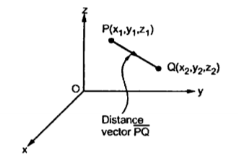
Figure 4. Cartesian coordinate system
 = x2
= x2  + y2
+ y2  + z2
+ z2 
Then the displacement from P to Q is represented by the distance vector  and is given by
and is given by
 =
=  -
-  = [x2 -x1]
= [x2 -x1]  + [ y2 -y1]
+ [ y2 -y1]  + [z2 -z1]
+ [z2 -z1] 
This is called separation vector.
The magnitude of the vector is given by
| | = √ (x2 -x1) 2 + (y2 -y1) 2 +(z2 – z1) 2
| = √ (x2 -x1) 2 + (y2 -y1) 2 +(z2 – z1) 2
This is called as distance formula.
The unit vector along the direction PQ is given by
 PQ = Unit vector along PQ =
PQ = Unit vector along PQ =  / |PQ|
/ |PQ|
Obtain the unit vector in the direction from the origin towards the point P(3,-3,-2)
Solution:
The origin O(0,0,0) while P(3,-3,-2) hence the distance vector  is
is
 = (3-0)
= (3-0)  + (-3-0)
+ (-3-0)  +(-2-0)
+(-2-0)  = 3
= 3  -3
-3  -2
-2 
 =
=  (3) 2 + (-3) 2 + (-2) 2 = 4.6904
(3) 2 + (-3) 2 + (-2) 2 = 4.6904
Hence the unit vector along the direction OP is
 OP =
OP =  / |
/ | | = 3
| = 3  -3
-3  -2
-2  / 4.6904 =
/ 4.6904 =
= 0.6396  -0.63963
-0.63963  -0.4264
-0.4264 
Given the three points in cartesian co-ordinate system as A(3,-2,1) B (-3,-3,5) , C (2,6,-4)
Find
i) The vector from A to C
ii) The unit vector from B to A
iii) The distance from B to C
iv) The vector from A to the mid-point of the straight line joining B to C.
The position vectors for the given points are:
 = 3
= 3  - 2
- 2  +
+  .
.
 = -3
= -3  - 3
- 3  + 5
+ 5  .
.
 = 2
= 2 +6
+6  -4
-4  .
.
i) The vector from A to C is
 =
=  -
-  = [ 2-3]
= [ 2-3]  +[6 –(-2)]
+[6 –(-2)]  +[-4-1]
+[-4-1]  .
.
= -  + 8
+ 8  -5
-5  .
.
ii) For unit vector from B to A obtain the distance vector  first
first
 =
=  -
- 
= [ 3 – (-3)] + [ (-2) –(-3) ]
+ [ (-2) –(-3) ]  + [ -4-1]
+ [ -4-1] 
= 6  +
+  -4
-4  .
.
| | =
| =  (6) 2 + (1) 2 + (-4)2 = 7.2801.
(6) 2 + (1) 2 + (-4)2 = 7.2801.
 BA =
BA =  / |
/ | | = 6
| = 6  +
+  -4
-4  ./ 7.2801
./ 7.2801
iii) For distance between B and C
 =
=  -
-  = [ 2 –(-3 ]
= [ 2 –(-3 ]  + [6-(-3)]
+ [6-(-3)]  +[-4) –(-5)]
+[-4) –(-5)]  = 5
= 5  + 9
+ 9  – 9
– 9 
Distance BC =  2 + (9) 2 + (-9) 2 = 13.6747
2 + (9) 2 + (-9) 2 = 13.6747
iv) Let B(x1,y1,z1 ) and C(x2,y2,z2) then the co-ordinates of the mid-point BC are (x1+x2/2 , y1+y2/2 , z1+z2/2)
The ranges of the variable are:
0 ≤ r ≤ ∞------------------(1)
0 ≤Ø≤ 2π------------------------------(2)
-∞≤z≤∞--------------------------------------------------(3)
The point P in cylindrical co-ordinate system has three co-ordinates r, Ø and z whose values lie in the ranges given by equations 1,2,3.
The point P(r,Ø1,z1) can be shown in figure (b)

Figure 5. Cylindrical coordinate system
The point P can be defined as the intersection of three surfaces in cylindrical co-ordinate system. These three surfaces are,
r = Constant which is circular cylinder with z axis as its axis
Ø= Constant plane which is a vertical plane perpendicular to xy plane making angle Ø with respect to xz plane.
z= Constant plane is a plane parallel to xy plane.
These surfaces are shown in figure.

Figure 6. Surfaces of cylindrical coordinate system
The intersction of any two surfaces out of the above three surfaces is either a line or a circle and intersection of three surfaces define a point.
The intersection of z=constant and r=constant is a circle. The intersection of ɸ=constant and r=constant is a line. The point P which is intersection of all three surfaces is shown in the figure.

Figure 7. Intersection
Base vectors:
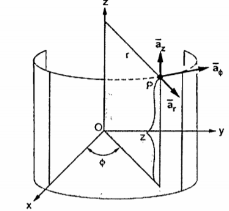
Figure 8. Base vector
These are mutually perpendicular to each other. The  lies in a plane parallel to xy plane and perpendicular to the surface of the cylinder at a given point coming radially outwards. The vector
lies in a plane parallel to xy plane and perpendicular to the surface of the cylinder at a given point coming radially outwards. The vector  lies also in a plane parallel to xy plane but it is tangent to the cylinder and pointing in the direction of increasing
lies also in a plane parallel to xy plane but it is tangent to the cylinder and pointing in the direction of increasing  at the given point.
at the given point.
The unit vector  is parallel to z-axis and directed towards increasing z . Hence, vector of point P can be represented as
is parallel to z-axis and directed towards increasing z . Hence, vector of point P can be represented as
 = P r
= P r  + P ɸ
+ P ɸ  + P z
+ P z 
Differential Elements in Cylindrical co-ordinate system
Consider o point P(r,ɸ,z) in a cylindrical co-ordinate system. Let each co-ordinate be increased by differential amount. The differential increments in r,ɸ,z are dr,dɸ and dz respectively.
There are two cylinders of radius r and r+dr. There are two radial planes at the angles ɸ and ɸ+dɸ. And there are two horizontal planes at the heights z+dz. All these surfaces enclose a small volume as shown in figure.
The different lengths in r and z are dz and dr respectively. In ɸ direction dɸ is the change in angle ɸ and is not the differential length. Due to this change dɸ there exists a differential arc length in ɸ direction. This differential length due to dɸ in ɸ direction is r dɸ as shown in figure.
Thus the differential lengths are:
dr = Differential length in r direction.
r dɸ = Differential length in ɸ direction
dz = Differential length in z direction
Hence the differential vector length in cylindrical co-ordinate system is given by
 = dr
= dr  + r dɸ
+ r dɸ  + dz
+ dz 
The magnitude of the differential length vector is given y
|
 (dr) 2 +( r d ɸ) 2 + (dz) 2
(dr) 2 +( r d ɸ) 2 + (dz) 2
Hence the differential volume of the differential element is given by
dv = r dr dɸ dz
The surfaces which are used to define the spherical co-ordinate system on the three cartesian axes are:
Thus the three co-ordinates of a point P in the spherical co-ordinate system are (r,Ѳ,Ø). These surfaces are shown in figure


Figure 9. Spherical coordinate system.

Figure 10. Points in the spherical coordinate system
The point P(r,Ѳ,Ø) can be represented in the spherical co-ordinate system as shown in figure. The angles Ѳ and Ø are measured in radians. The point P can be defined as the intersection of three surfaces in spherical co-ordinate system. These three surfaces are:
r = Constant which is a sphere with cenre as origin
Ɵ = Constant which is right circular cone with apex as origin and axis a z axis
ɸ= Constant is a plane perpendicular to xy plane.
Base Vector:
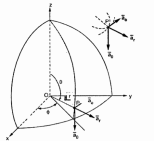
Figure 11. Base vector
There are three unit vectors in r, Ɵ and ɸ directions denoted as  ,
,  and
and  . These unit vectors are mutually perpendicular to each other as shown in figure. The unit vector
. These unit vectors are mutually perpendicular to each other as shown in figure. The unit vector  is directed from the centre of the sphere that is the origin to the given point P. It is radially outward normal to the sphere. It lies in the cone Ɵ = constant and plane ɸ= constant.
is directed from the centre of the sphere that is the origin to the given point P. It is radially outward normal to the sphere. It lies in the cone Ɵ = constant and plane ɸ= constant.
The unit vector  is tangent to the sphere and oriented in the direction of increasing Ɵ. It is normal to the conical surface.
is tangent to the sphere and oriented in the direction of increasing Ɵ. It is normal to the conical surface.
The third unit vector  is tangent to the sphere and also tangent to the conical surface. It is oriented in the direction of increasing ɸ. It is same as defined in the cylindrical co-ordinate system.
is tangent to the sphere and also tangent to the conical surface. It is oriented in the direction of increasing ɸ. It is same as defined in the cylindrical co-ordinate system.
Hence, vector P is
Differential elements in Spherical co-ordinate system.
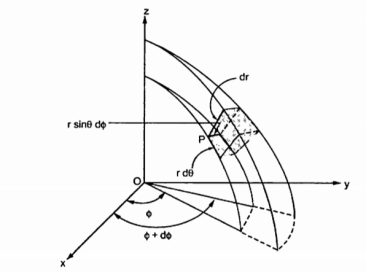
Figure 12. Spherical coordinate system
Consider a point P(r,Ɵ,ɸ) in spherical co-ordinate system. Let each co-ordinate be increased by the differential amount. The differential increments in r,Ɵ,ɸ are dr,dƟ and dɸ.
Now there are two spheres of radius r and r+dr . There are two cones with half angles Ɵ and Ɵ+dƟ. There are two planes at the angles ɸ+dɸ measured from xz plane. All these surfaces enclose a small volume as shown in figure.
dr= Differential length in r direction
r d Ɵ = Differential length in Ɵ direction
r sin Ɵ dɸ = Differential length in ɸ direction.
Hence the differential vector length in spherical coordinate system is
The magnitude of the differential length vector is
| | = √ (dr) 2 + (r d
| = √ (dr) 2 + (r d 2 + (r sin
2 + (r sin  dɸ) 2
dɸ) 2
Hence differential volume is given by
dv = r 2 sin  dr d
dr d d
d 
Key Take Aways:
A Cartesian coordinate system is a coordinate system that specifies each point uniquely in a plane by a set of numerical coordinates, which are the signed distances to the point from two fixed perpendicular oriented lines, measured in the same unit of length.
Consider a scalar valued function of scalar for example time -dependent density of a material  =
= 
Consider vector valued function of scalar for example time -dependent displacement of a particle u = u(t). In this case the derivative in the usual way
du/dt = lim ∆t->0 u(t+∆t) – u(t) / ∆t
which turns out to be simply the derivative co-efficient
du/dt = du1/dt e1 + du2/dt e2 + du3/dt = dui/dt ei
Partial differentiation:
Partial derivatives can also be defined. For example if u is a function of the coordinates u(x1,x2,x3) then
∂u/ ∂x1 = lim ∆x1->0 u(x1+ ∆x1 ,x2,x3) – u( x1,x2,x3) / ∆x1
Integration
The line integrals of vector fields as a line integral with respect to arc length as follows,
where →T(t) is the unit tangent vector and is given by,
 (t) =
(t) =  ’(t) ||
’(t) || ’(t)||
’(t)||
To compute line integrals with respect to arc length we can see that this second form is equivalent to the first form given above.
 . d
. d  =
=  .
.  ds
ds
=  (
(  ‘(t) / ||
‘(t) / ||  ‘(t) || ||
‘(t) || || ‘(t) || dt
‘(t) || dt
=  (
(  ‘(t) ) .
‘(t) ) .  ‘(t) dt
‘(t) dt
1.4.1 Differential length
Differential Elements in Cartesian Co-ordinate System
Consider a point P(x,y,z) in the rectangular co-ordinate system . If we increase each co-ordinate by a differential amount a new point P’ will be obtained having co-ordinates (x+dx, y +dy , z+dz)
dx = differential length in x-direction
dy = differential length in y-direction
dz = differential length in z-direction
Hence differential vector length called elementary vector length
 = dx
= dx  - dy
- dy  - dz
- dz  .
.
P is the intersection of the three planes and P’ is the intersection of the new three planes which are displaced from original three planes. These six planes together define a differential volume which is a rectangular parallelepiped as shown in the figure.
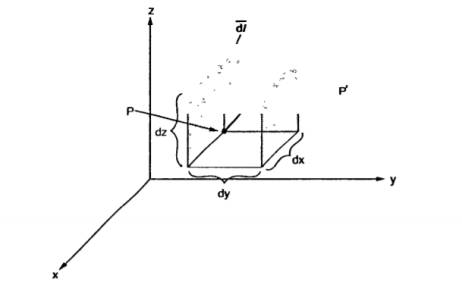
Figure 13. Cartesian coordinate system
 = dx
= dx  - dy
- dy  - dz
- dz  .
.
Hence the differential volume of the rectangular parallelpiped is given by
dv = dx dy dz
 is vector and dv is scalar.
is vector and dv is scalar.
The differential surface area is given by
 =
= 
 n
n
ds = Different surfaces area of the element .

Figure 14. Differential vector system
d = Differential vector surface area normal to x direction dy dz
= Differential vector surface area normal to x direction dy dz 
d = = Differential vector surface area normal to y direction dx dz
= = Differential vector surface area normal to y direction dx dz 
d = = Differential vector surface area normal to y direction dx dy
= = Differential vector surface area normal to y direction dx dy 
1.4.2 Area and volume
A uniformly charges volume with charge density  of infinite extent in the x and z directions and width 2a is centered about the y-axis as shown in figure. We break the volume distribution into incremental sheets of surface charge of width dy’ with differential surface charge density d
of infinite extent in the x and z directions and width 2a is centered about the y-axis as shown in figure. We break the volume distribution into incremental sheets of surface charge of width dy’ with differential surface charge density d =
=  .
.
It is necessary to distinguish the position y’ of the differential sheet of surface charge from the field point y. The total electric field is the sum of all the fields due to each differentially charged sheet.
This breaks up into three regions :
Region 1: y a each surface charge element causes a field in the negative y direction.
a each surface charge element causes a field in the negative y direction.
Ey =  / 2
/ 2  dy’ =
dy’ =  a/
a/  y
y  -a
-a
Similarly in region III where y  a each charged sheet gives rise to a field in the positive y direction:
a each charged sheet gives rise to a field in the positive y direction:
Ey =  / 2
/ 2  dy’ =
dy’ =  a/
a/ 
In region (2) where -a  y
y a the charge to the right of y gives rise to negatively directed field while the charge to the left of y causes a positively directed field :
a the charge to the right of y gives rise to negatively directed field while the charge to the left of y causes a positively directed field :
Ey =  / 2
/ 2  dy’ +
dy’ +  / 2
/ 2  dy’ =
dy’ =  /
/  -a
-a 
Thus, the field is constant outside the volume of charge.
1.4.3 Line surface and volume integrals
The electric field intensity due to point charge Q is given by
 = Q/ 4 π
= Q/ 4 π  R 2
R 2 
 due to line charge:
due to line charge:

Figure 15. Line charge
Consider a line charge distribution having charge density  L as shown in figure.
L as shown in figure.
The charge dQ on the differential length dl is
dQ =  L dl----------------(1)
L dl----------------(1)
Hence the differential electric field d at point P due to dQ is given by
at point P due to dQ is given by
d = dQ/ 4
= dQ/ 4 
 R 2
R 2  =
=  L dl / 4
L dl / 4 
 R 2
R 2  ----------------------(2)
----------------------(2)
Hence the total  at a point P due to line charge can be obtained by integrating d
at a point P due to line charge can be obtained by integrating d  over the length of the charge.
over the length of the charge.
 =
=  dl/ 4
dl/ 4 
 R 2
R 2 
The  and dl can be obtained depending upon the coordinate system used.
and dl can be obtained depending upon the coordinate system used.
 due to surface charge.
due to surface charge.

Figure 16. Surface charge
Consider a surface charge distribution having a charge density  s as shown in the figure. The charge dQ on the differential surface area dS is
s as shown in the figure. The charge dQ on the differential surface area dS is
dQ =  s dS.
s dS.
Hence the differential electric field d  at a point due to dQ is given by,
at a point due to dQ is given by,
d = dQ/ 4
= dQ/ 4 
 R 2
R 2  =
=  dS/ 4
dS/ 4 
 R 2
R 2 
Hence the total  at a point P is to be obtained by integrating d
at a point P is to be obtained by integrating d over the surface area on which charge is distributed.
over the surface area on which charge is distributed.
 due to Volume charge
due to Volume charge
Consider a volume charge distribution having a charge density  v as shown in the figure.
v as shown in the figure.
The charge dQ on the differential volume dv is
dQ =  v dv
v dv
Hence the differential electric field d at a point P due to dQ is given by
at a point P due to dQ is given by
d = dQ/ 4
= dQ/ 4 
 R 2
R 2  =
=  v dv/ 4
v dv/ 4 
 R 2
R 2 
Hence the total  at a point P is to be obtained by integrating d
at a point P is to be obtained by integrating d over the volume in which charge is accumulated.
over the volume in which charge is accumulated.
 =
=  dv / 4
dv / 4 
 R 2
R 2 
The  and dv must be obtained according to the co-ordinate system used.
and dv must be obtained according to the co-ordinate system used.
Thus, if there are all possible types of charge distribution then the total  at a point is the vector sum of individual electric field intensities produced by each of the charges at a point under consideration.
at a point is the vector sum of individual electric field intensities produced by each of the charges at a point under consideration.
 total =
total =  p +
p +  l +
l +  s +
s +  v
v
 p ,
p ,  l ,
l ,  s ,
s ,  v are the field intensities due to point , line, surface and volume charge distributions respectively.
v are the field intensities due to point , line, surface and volume charge distributions respectively.
Consider that in space let W be the unique function of x,y,z co-ordinates in the cartesian system. This is scalar function denoted as W(x,y,z) . Consider the vector operator in cartesian system denoted as  called del. It is defined as
called del. It is defined as
Let ɸ(x) be a scalar field. The gradient of ɸ is vector field defined as
 ɸ = ∂ɸ/ ∂x1 e1 + ∂ɸ2/∂x2 e2 + ∂ɸ3/∂x3 e3
ɸ = ∂ɸ/ ∂x1 e1 + ∂ɸ2/∂x2 e2 + ∂ɸ3/∂x3 e3
= ∂ɸ/∂xi ei = ∂ɸ/∂x. is important as it takes the dot product of  ɸ with dx it gives the increment in ɸ
ɸ with dx it gives the increment in ɸ
 ɸ . dx = ∂ɸ/∂xi ei . dxj ej
ɸ . dx = ∂ɸ/∂xi ei . dxj ej
= ∂ɸ/∂xi . dxi = dɸ
= ɸ(x+dx) - ɸ(dx)

Figure 17. Gradient of a vector
Properties:
The various properties of a gradient of a scalar field W are :





It is seen that  . d
. d gives the flux flowing across the surface S. Then mathematically divergence is define as the net outward flow of the flux per unit volume of the flux per unit volume over a closed incremental surface. It is denoted as
gives the flux flowing across the surface S. Then mathematically divergence is define as the net outward flow of the flux per unit volume of the flux per unit volume over a closed incremental surface. It is denoted as
div  = lim w->0
= lim w->0  . d
. d = Divergence of
= Divergence of 
Divergence theorem states that the volume integral of the divergence vector field is equal to the net outward flux of the vector through the closed surface that bounds the volume.
Mathematically 
 dv =
dv = 

Let us consider a volume V enclosed by a surface S. Let us subdivide the volume in large number of cells. Let the kth cell has a volume ∆ Vk and the corresponding surface is denoted by Sk. Interior to the volume cells have common surfaces. Outward flux through these common surfaces from one cell becomes the inward flux for the neighbouring cells. Therefore, when the total flux from these cells are considered we actually get the net outward flux through the surface surrounding the volume. Hence, we can write

 =
= 

 =
= 

 /
/  Vk . ∆ Vk
Vk . ∆ Vk
In the limit that is when k->∞ and ∆ Vk -> 0 the right hand of the expression can be written as
 dv . Hence we get
dv . Hence we get 
 dv =
dv = 

The circulation of a vector field around closed path is given by curl of vector. Mathematically it is defined as
Curl of  = lim ∆ SN ->0
= lim ∆ SN ->0  . d
. d
 N = Area enclosed by the line integral in normal direction
N = Area enclosed by the line integral in normal direction
Thus, maximum circulation of  per unit area tends to zero whose direction is normal to the surface is called curl of
per unit area tends to zero whose direction is normal to the surface is called curl of  .
.
Symbolically it is represented as
For a simple region D with bounding curve C = ∂ D and two C’ function P and Q on D we have
 + Q dy =
+ Q dy =  ∂Q/∂x - ∂P/∂y) dx dy
∂Q/∂x - ∂P/∂y) dx dy
Area of region is
A = 
 2 is called Laplacian operator.
2 is called Laplacian operator.
In cartesian co-ordinate system,
 2 . V =
2 . V =  2 V /
2 V /  x 2 +
x 2 +  2 V /
2 V /  y 2 +
y 2 +  2 V /
2 V /  z 2
z 2
In cylindrical co-ordinate system
 2 . V =
2 . V =  1/r
1/r  /
/  ( r
( r  V/
V/  ) + 1/ r 2 (
) + 1/ r 2 (  2 V /
2 V /  ɸ 2 ) +
ɸ 2 ) +  2 V /
2 V /  z 2
z 2
References
































